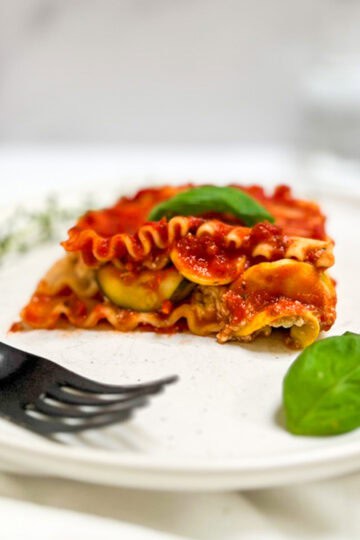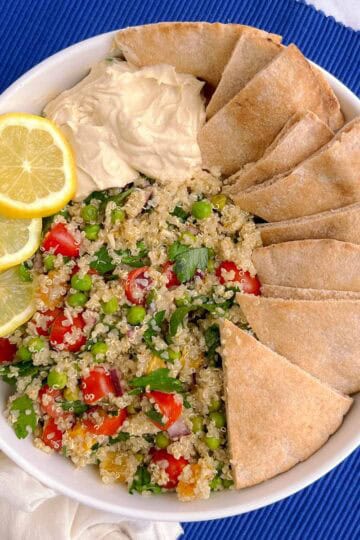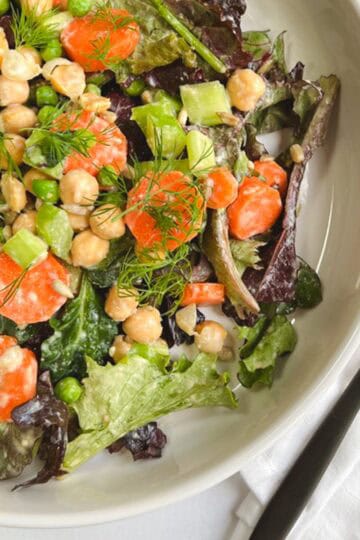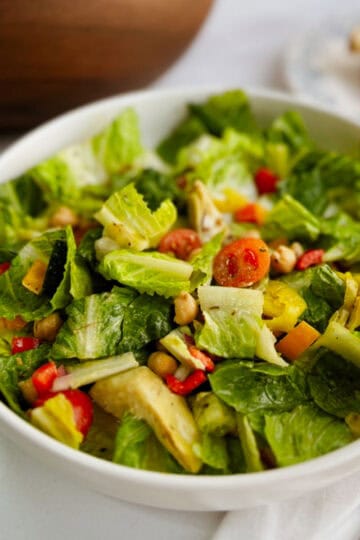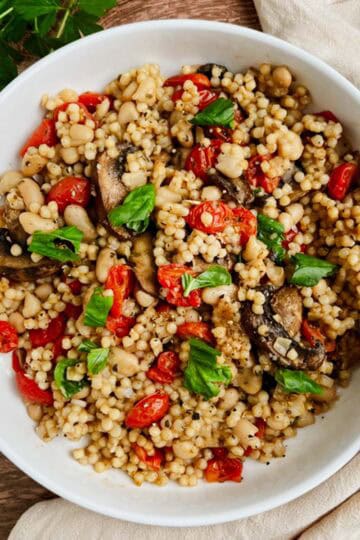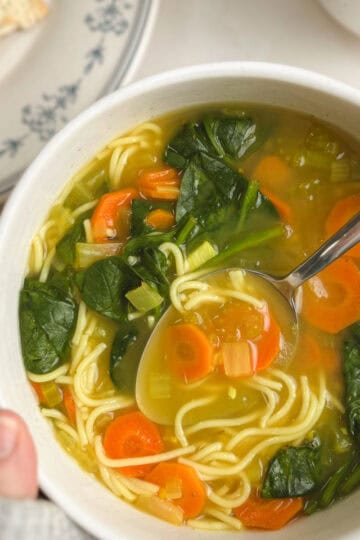Eat your greens with this light, fluffy green couscous risotto. Featuring asparagus, spinach, and peas and a bright, herbal seasoning, this oil-free and dairy-free dish is a delicious and healthy alternative to traditional risotto.
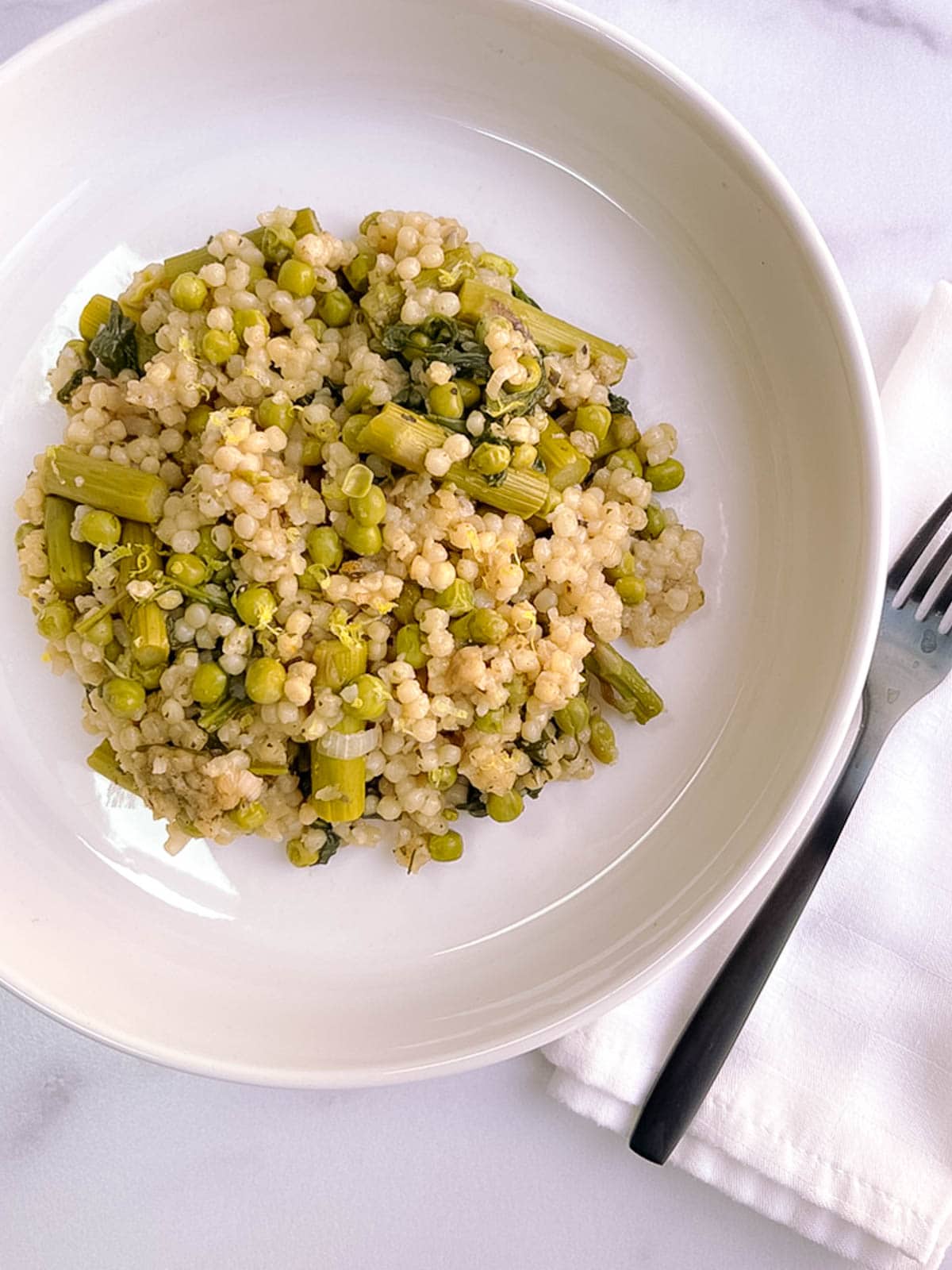
Jump to:
Why you’ll love this recipe
- Seasonal: What better way to welcome spring than a dish that celebrates fresh spring greens? Green couscous risotto uses fresh asparagus, spinach, and peas, which are all at their peak.
- Light and flavorful: After months of heavier winter recipes, this lighter dish is a welcome change. An aromatic herbal blend and white wine enhance the natural sweetness of the peas and asparagus, adding flavor and complexity.
- Healthy: Traditional risotto contains cheese, along with oil and/or butter. This version omits oil and dairy, cutting down on fat and cholesterol.
Ingredients
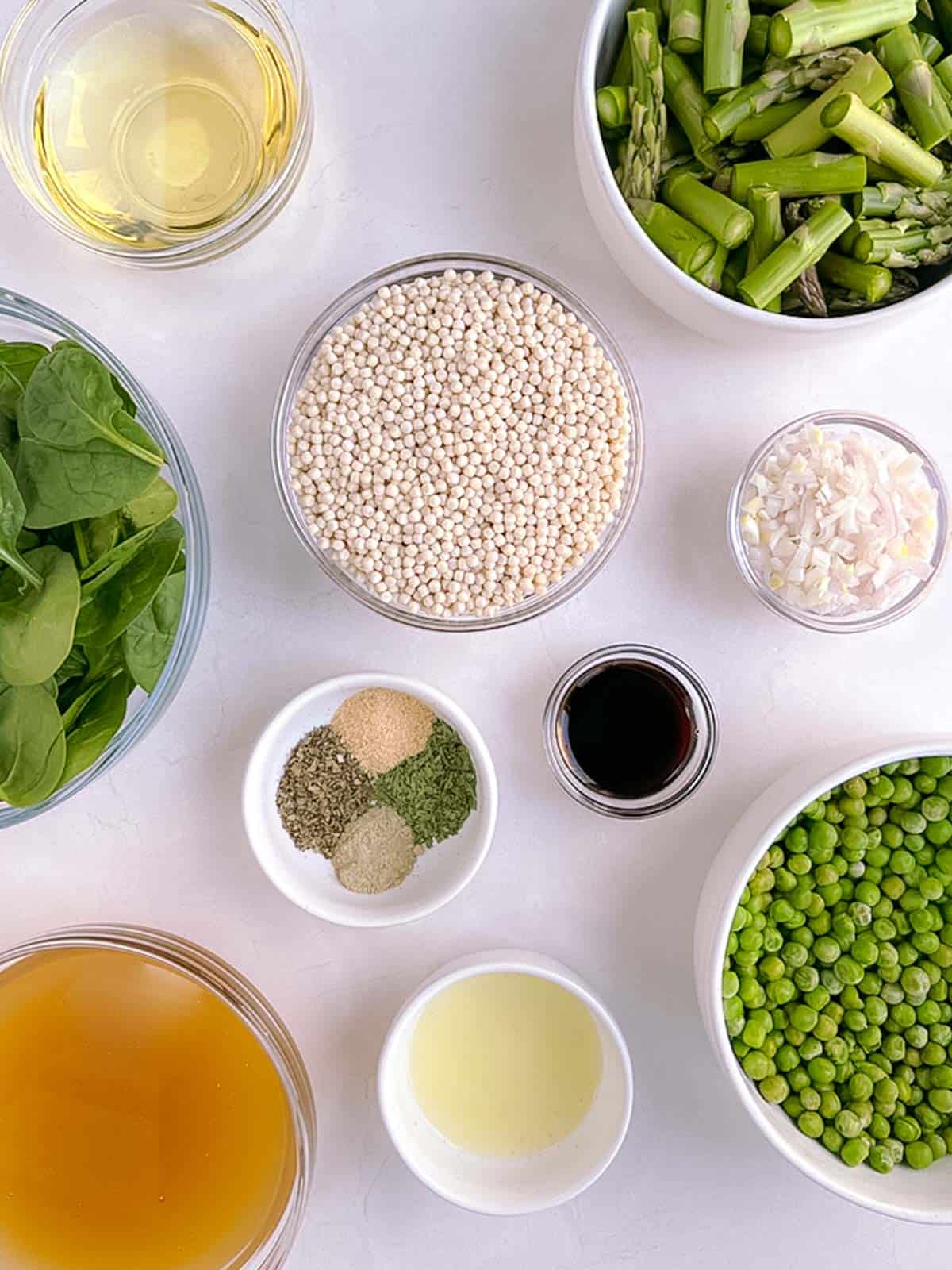
- Asparagus: Asparagus has a mild flavor and a tender sweetness when cooked. It is high in a range of vitamins and is a good source of fiber, folate, and antioxidants.
- Shallot: Shallots have a less intense flavor than onions, adding a subtle savory flavor without overpowering the dish. Like onions, shallots are high in antioxidants and sulfur compounds, supporting heart health and digestion and reducing inflammation.
- Balsamic vinegar: Balsamic vinegar is a great alternative to roasting in olive oil, as it contributes sweetness, moisture, and flavor without added fat.
- Dried basil: Adds a distinctive herby flavor. Basil has anti-inflammatory and antibacterial properties.
- Dried tarragon: Tarragon contributes an uplifting aroma and a unique, subtle flavor that some have described as licorice-like. Tarragon has been traditionally used as a digestive aid.
- Garlic powder: Garlic powder adds a mild flavor boost and helps support heart health.
- Ground white pepper: White pepper is similar in flavor to black pepper, but is less intense and adds a warm, slightly earthy undertone. You can use black pepper as a substitute, but use a smaller amount to avoid overpowering the other flavors.
- Kosher salt (optional): The small amount used here enhances the overall flavor. Omit if you are reducing your sodium intake for health reasons.
- Low-sodium vegetable broth: For cooking the couscous. While water can be used as a substitute in a pinch, vegetable broth adds subtle savory and herbal flavors that will give the dish a more complex, nuanced flavor profile.
- White wine: White wine brings a subtle sweetness and fruity flavor to the dish, adding complexity. To make green couscous risotto alcohol-free, replace the white wine with an additional ½ cup of low-sodium vegetable broth.
- Pearl couscous: Pearl couscous (also sold as Israeli couscous) has a soft, chewy texture and absorbs the flavor of the other ingredients. It is made from wheat flour and is a good source of protein. As it contains wheat, however, it is not gluten free.
- Peas: Peas add sweetness, color, and a tender texture. They are high in protein as well as vitamins and antioxidants.
- Fresh spinach leaves: A well-known superfood, spinach is high in vitamins A, C, and K, along with iron and folate.
- Freshly squeezed lemon juice: Adds brightness and tang. Lemon juice is high in vitamin C, which supports the immune system.
See recipe card for quantities.
Instructions
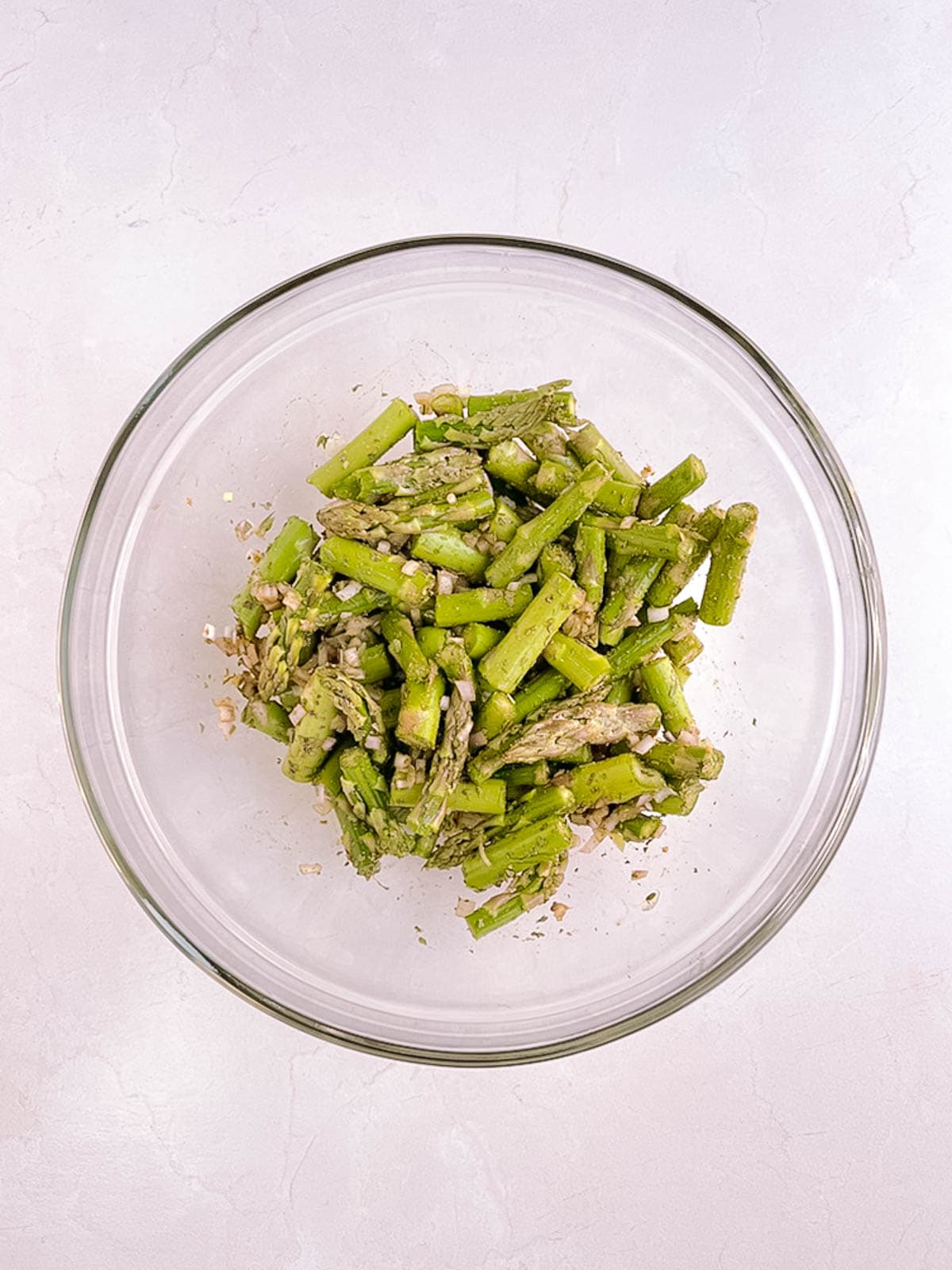
Step 1: In a large bowl, toss the asparagus, shallot, balsamic vinegar, dried basil, dried tarragon, garlic powder, white pepper, and kosher salt (if using).
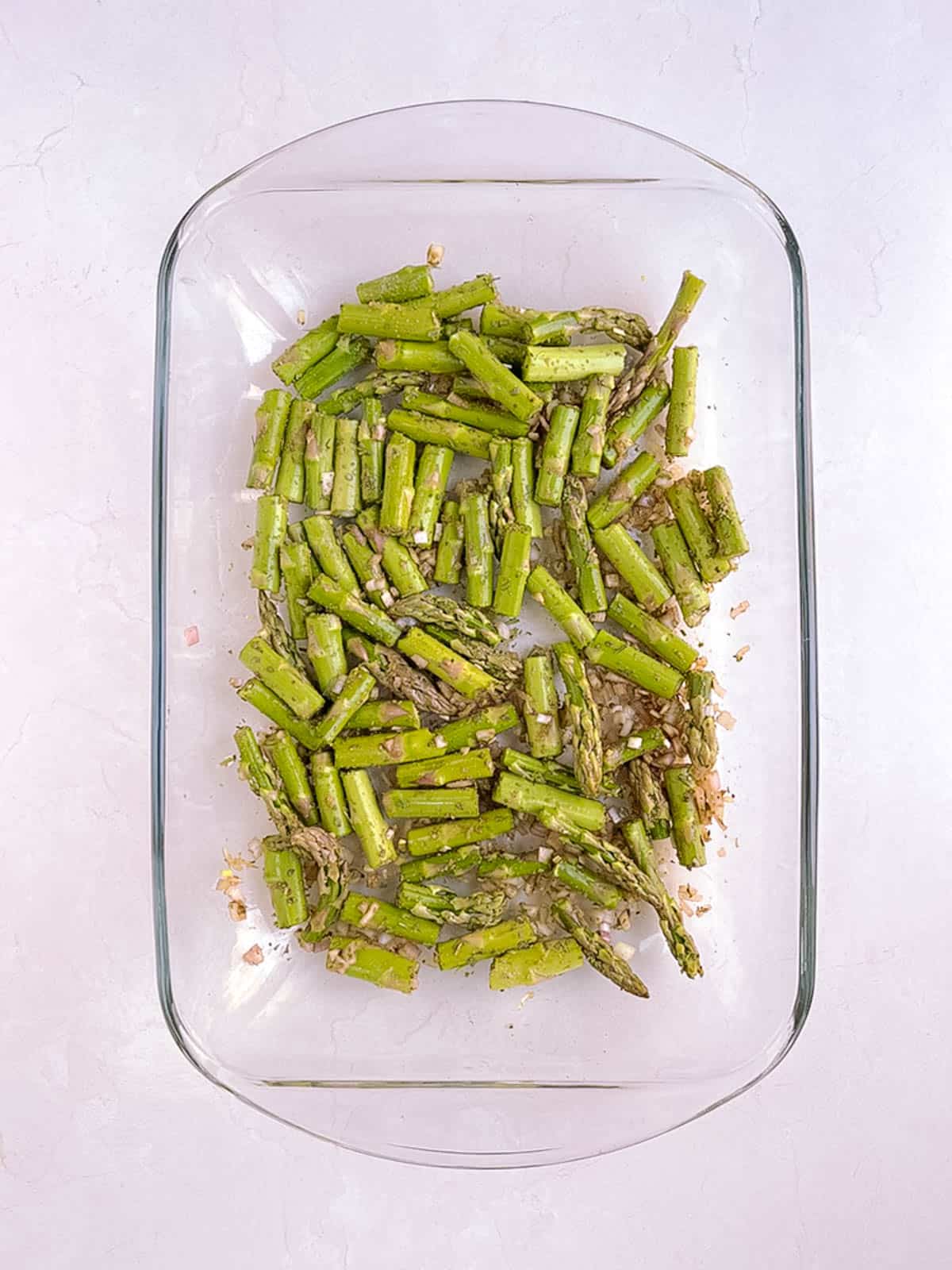
Step 2: Add the mixture to a 9×13-inch casserole dish, spreading it out evenly. Roast for 10 to 15 minutes, or until the asparagus is fork-tender but not limp.
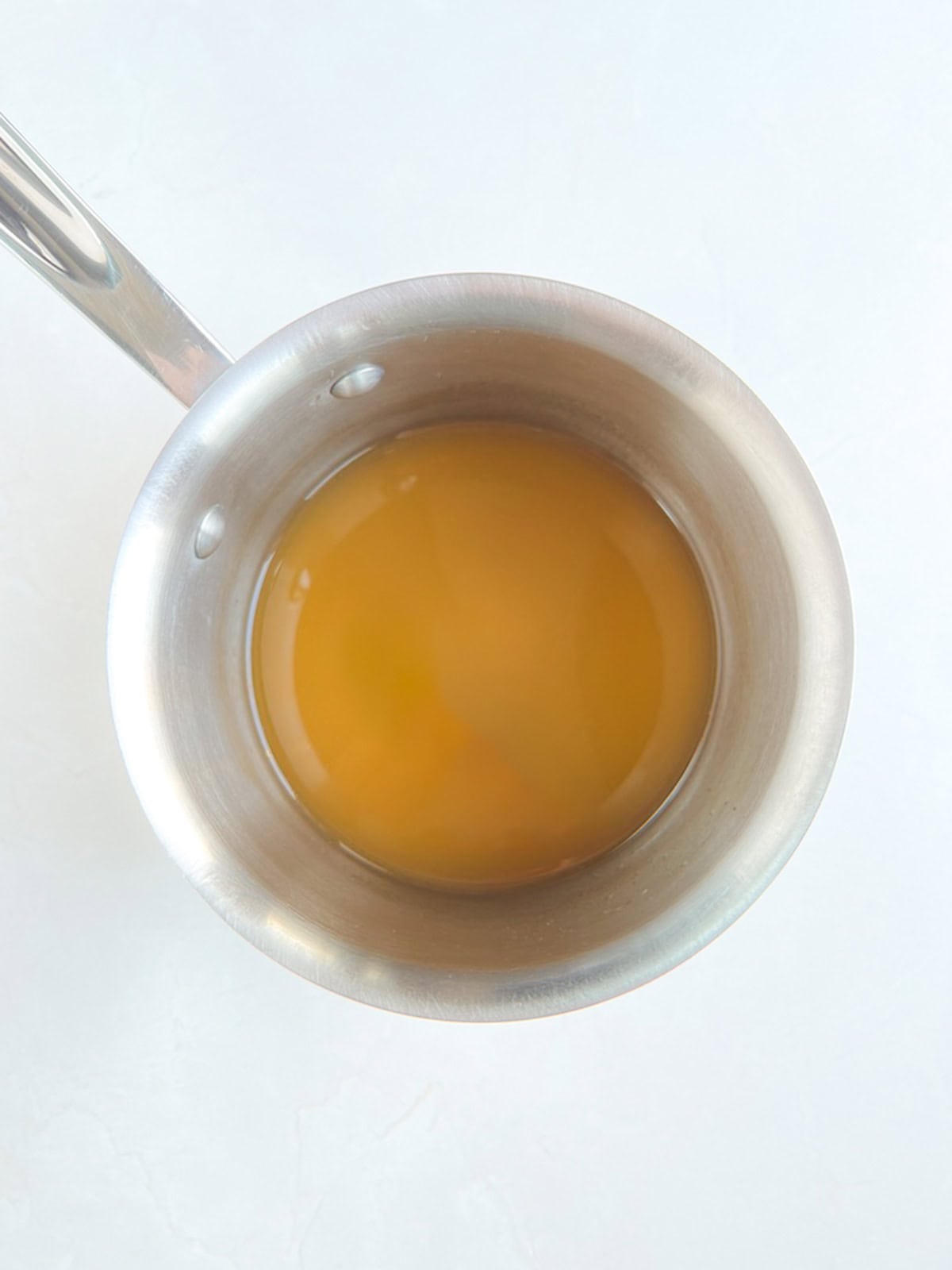
Step 3: While the asparagus and shallot are roasting, boil the vegetable broth and white wine in a small pot on the stove.
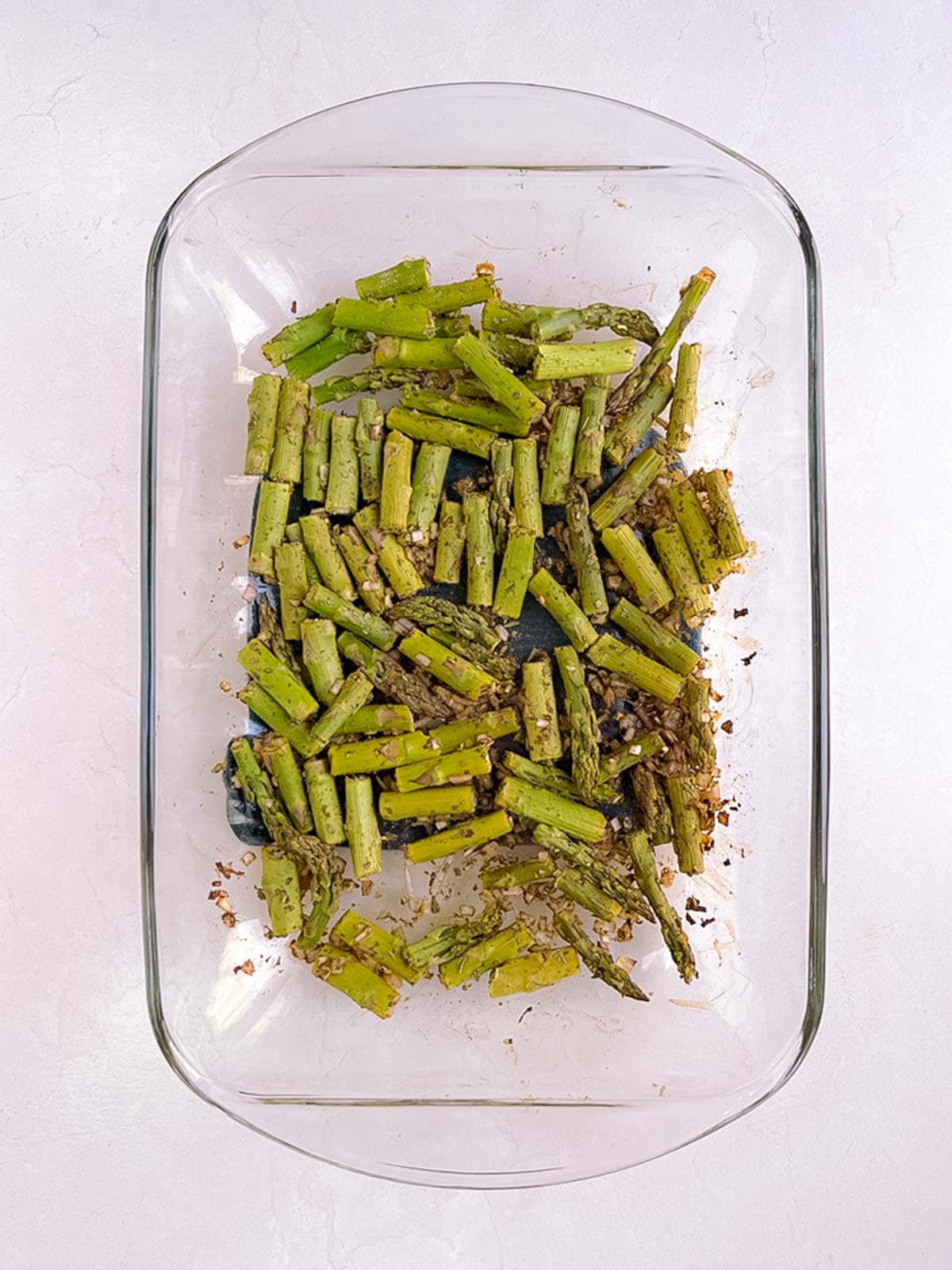
Step 4: At the end of the asparagus and shallot roasting time, remove the casserole dish from the oven.
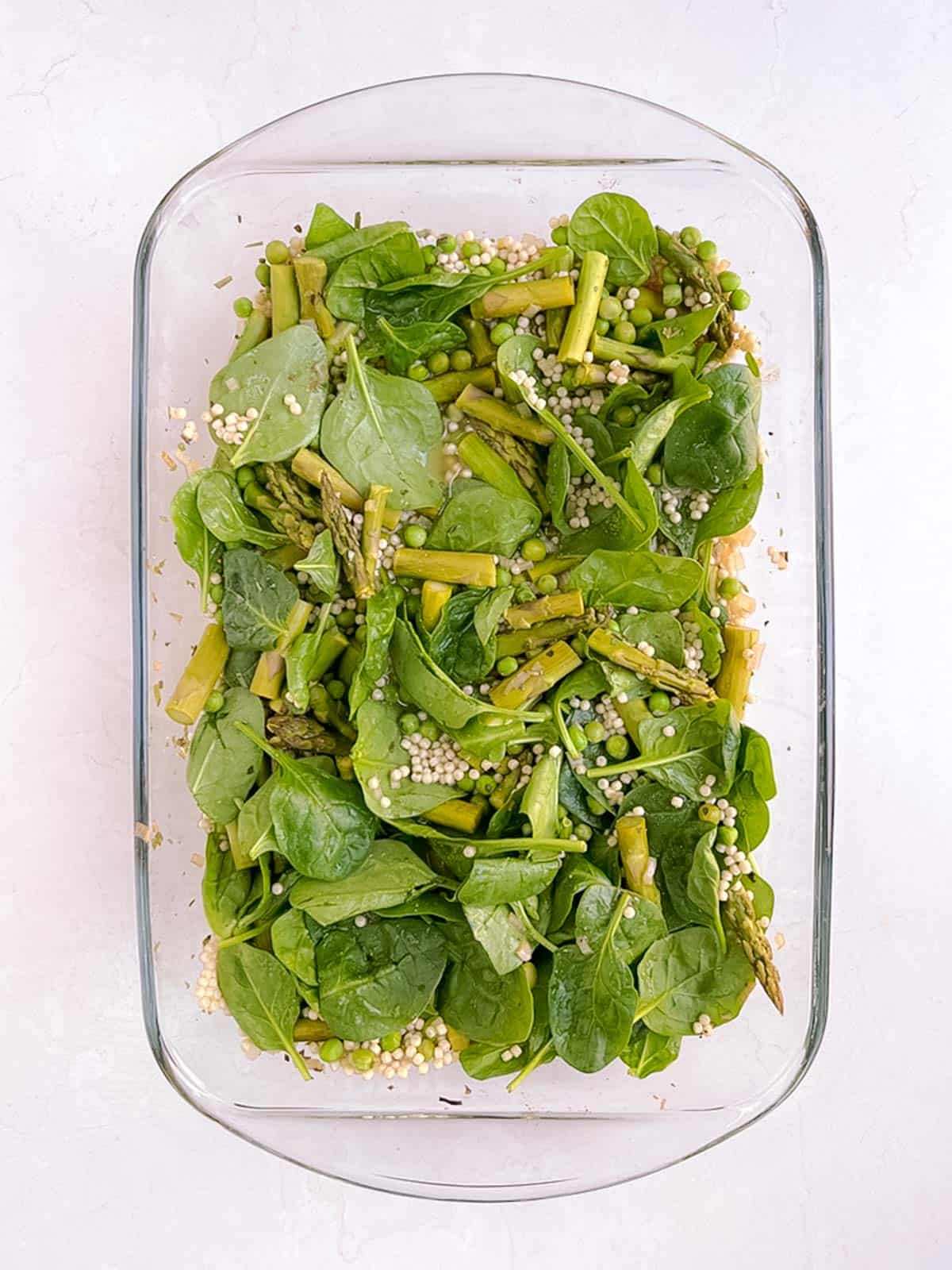
Step 5: Add the couscous, peas, and spinach to the casserole dish. Carefully pour the broth-and-wine mixture on top. Press down gently with the back of a spoon to submerge the couscous and vegetables as much as possible. Cover the casserole dish with aluminum foil and return it to the oven for 20 to 25 minutes, or until the couscous is soft and has absorbed the liquid.
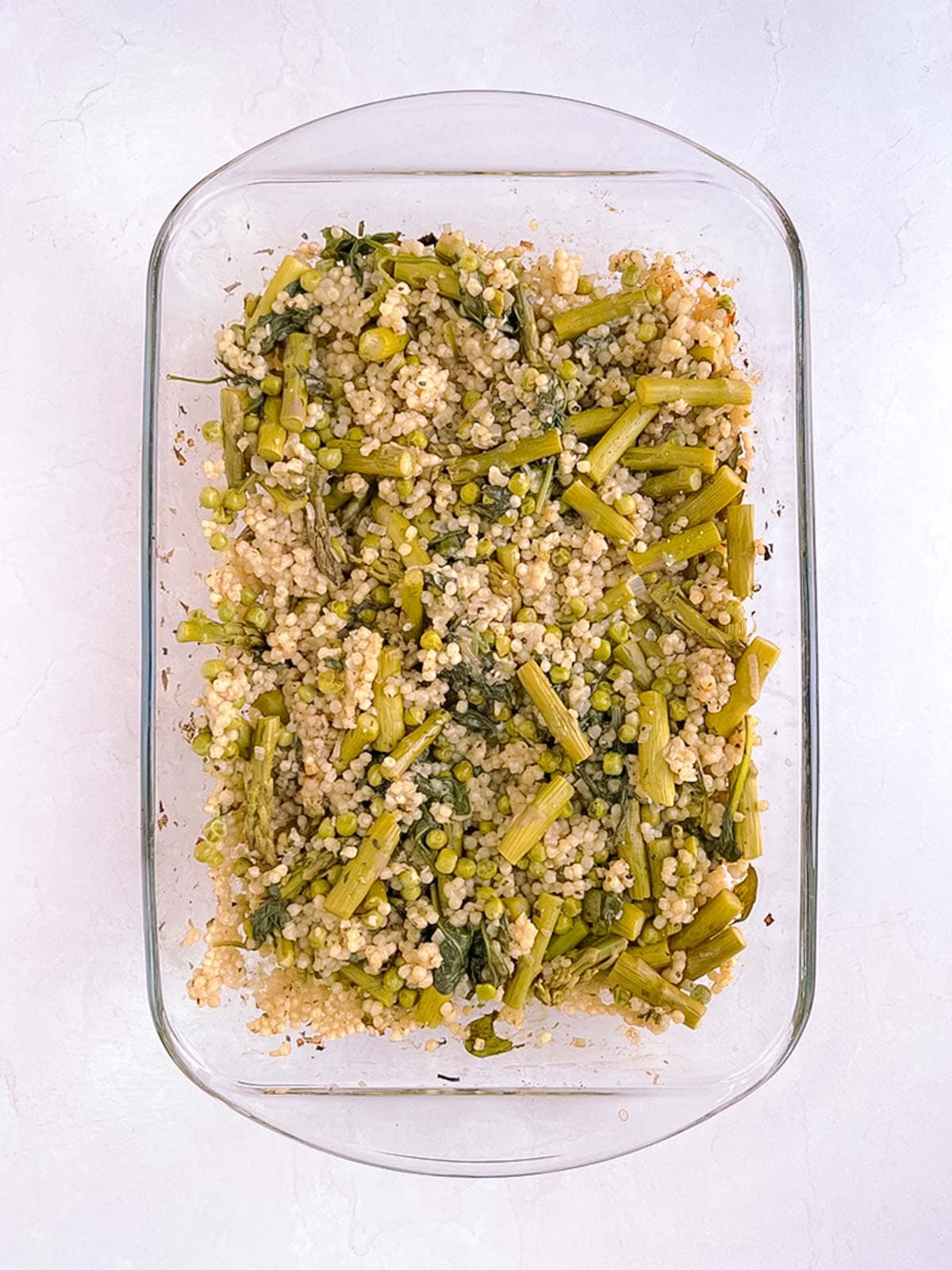
Step 6: Remove the casserole dish from the oven and stir well. If any couscous remains uncooked (this may happen around the edges), add additional broth or water 1 tablespoon at a time, stir well, and return the casserole dish to the oven for 1 to 2 more minutes, until the liquid is absorbed. Once the couscous is completely cooked, remove the dish from the oven, add 1 teaspoon of lemon juice, stir, and taste. If you prefer more lemon flavor, add more lemon juice in increments, tasting as you go, to avoid overpowering the other flavors. If desired, garnish with vegan Parmesan, nutritional yeast, fresh basil leaves, lemon zest, freshly cracked black pepper, and/or a pinch of flaky sea salt. Serve warm.
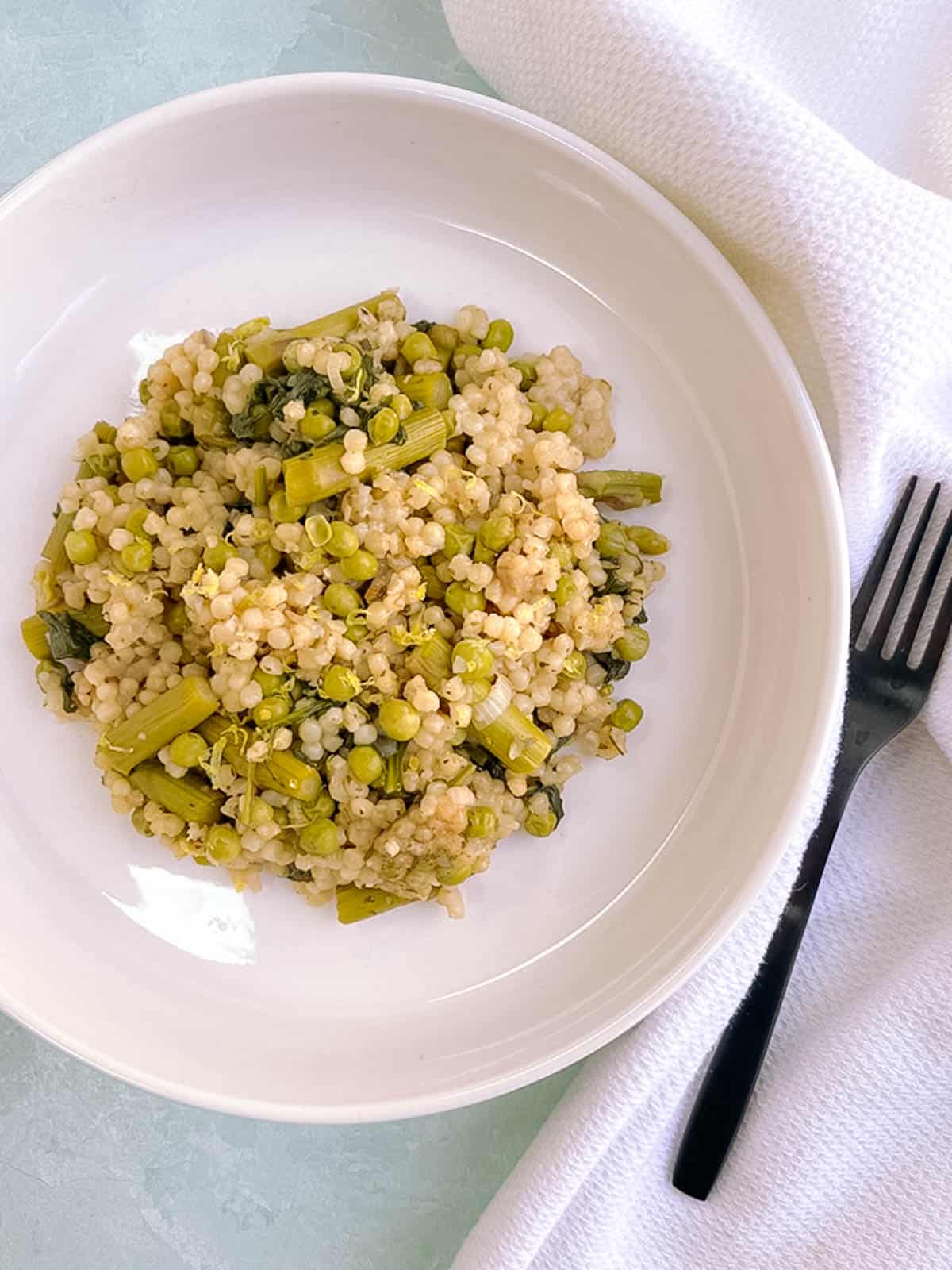
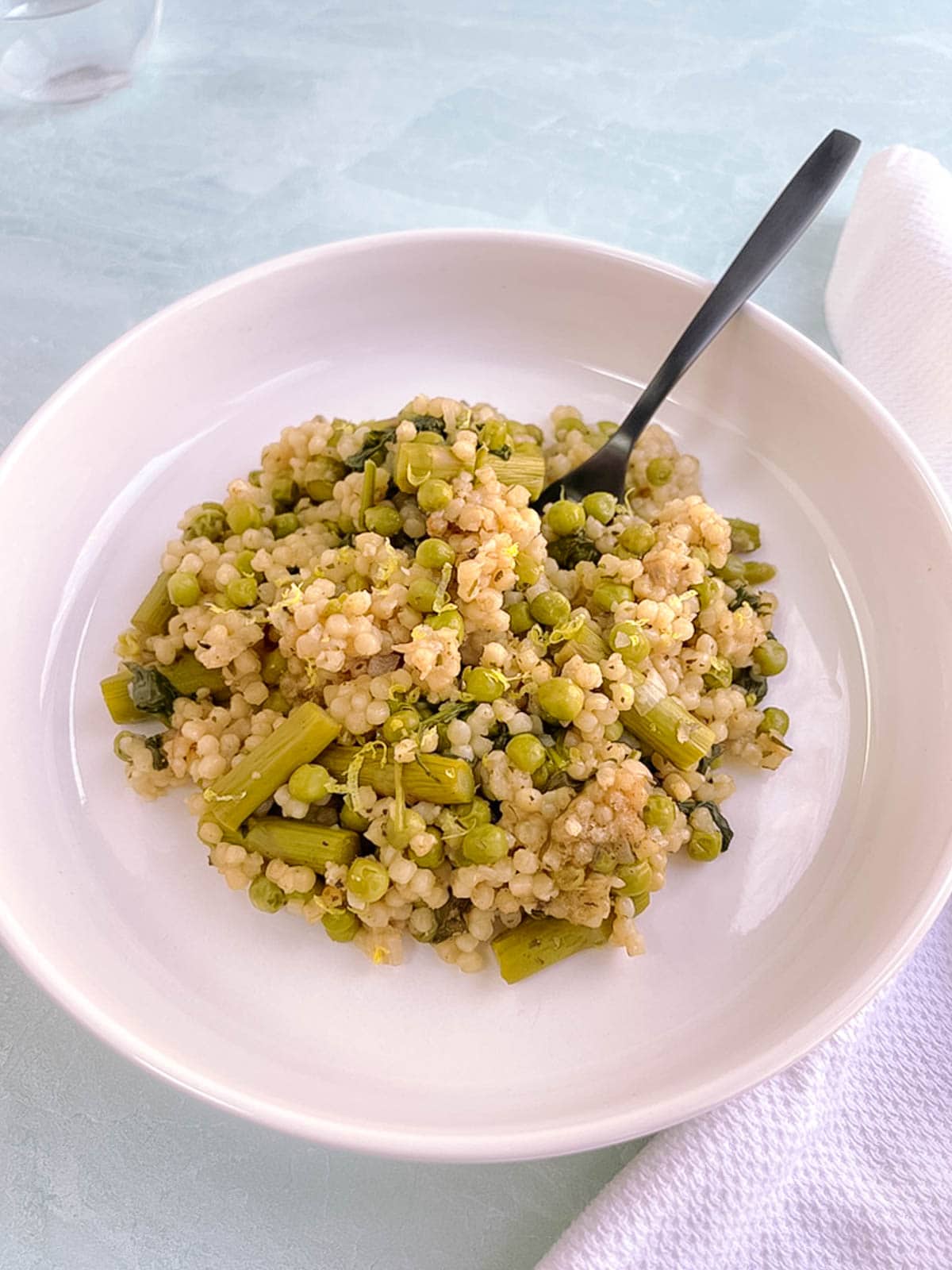
Variation
Try this couscous risotto variation for a version of this dish featuring the deep, rich flavors of tomatoes and mushrooms.
Equipment
- 9×13-inch casserole dish
- Cutting board
- Sharp knife
- Measuring cups
- Measuring spoons
- Small pot
- Aluminum foil
Storage
Store leftover green couscous risotto in the fridge for up to 5 days or freeze in a sealed container for up to 1 month.
Top Tip
After roasting the asparagus and shallot, add the couscous, peas, and spinach before adding the broth-and-wine mixture. Doing so in this order will ensure that the spinach is fully submerged in the broth, helping it cook down instead of drying out.
FAQ
The thicker, woody bottoms of the asparagus stalks are tough and should be removed before adding them to this dish. To do so, slice them with a knife where the green color of each stalk starts to fade to white. Alternatively, hold each asparagus stalk at the ends, gently bending the ends toward you until the stem snaps naturally at the area where the asparagus starts to become woody. You can either compost the asparagus ends or use them to make vegetable stock.
Traditional risotto is made with Arborio rice and requires stirring over a stove for a long period of time to achieve its creamy texture. In contrast, this couscous risotto is made with pearl couscous, which has a pasta-like consistency and can be baked in the oven.
Pearl couscous is very similar to Israeli couscous (stores often carry one kind or the other, and people often use the terms interchangeably). Unlike regular couscous, which is small and grainy, pearl/Israeli couscous is larger, softer, and more pasta-like. It is made from semolina wheat, which is used to make pasta.
No. Regular couscous is smaller and grainer in texture and won’t give you the same fluffy, pasta-like result. I have not tried this recipe with other types of pasta; however, you could likely substitute pearl couscous with a smaller pasta, such as orzo.
This recipe is not gluten free because pearl couscous is made from semolina wheat, which contains gluten. To make this recipe gluten free, you could try substituting an equal amount of gluten-free pasta. I have not tried this variation yet to confirm, however, so it is possible that the cook time and results may be different.
Related
Looking for other main dish ideas? Try these:
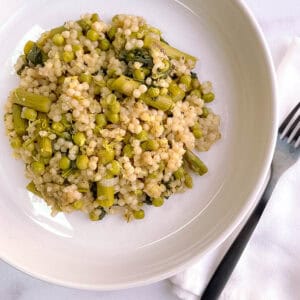
Green Couscous Risotto
Equipment
- 9×13-inch casserole dish
- cutting board
- sharp knife
- measuring cups
- measuring spoons
- small pot
- aluminum foil
Ingredients
- 1 bunch asparagus (approximately 1 pound) cut into 1-inch pieces (see FAQ)
- 1 shallot finely diced
- 1 tablespoon balsamic vinegar
- 1 teaspoon dried basil
- 1 teaspoon dried tarragon
- 1 teaspoon garlic powder
- ½ teaspoon ground white pepper
- ¼ teaspoon kosher salt (optional)
- 1½ cups + 2 tablespoons low-sodium vegetable broth plus additional broth as needed
- ½ cup white wine
- 1½ cups pearl couscous
- 1½ cups peas fresh or frozen
- 2 handfuls fresh spinach leaves
- 1 tablespoon freshly squeezed lemon juice plus more to taste
Optional garnishes
- vegan Parmesan
- nutritional yeast
- fresh basil leaves
- lemon zest
- freshly cracked black pepper
- flaky sea salt
Instructions
- Preheat the oven to 425°F.
- In a large bowl, toss the asparagus, shallot, balsamic vinegar, dried basil, dried tarragon, garlic powder, white pepper, and kosher salt (if using).
- Add the mixture to a 9×13-inch casserole dish, spreading it out evenly. Roast for 10 to 15 minutes, or until the asparagus is fork-tender but not limp.
- While the asparagus and shallot are roasting, boil the vegetable broth and white wine in a small pot on the stove.
- At the end of the asparagus and shallot roasting time, remove the casserole dish from the oven.
- Add the couscous, peas, and spinach to the casserole dish. Carefully pour the broth-and-wine mixture on top. Press down gently with the back of a spoon to submerge the couscous and vegetables as much as possible. Cover the casserole dish with aluminum foil and return it to the oven for 20 to 25 minutes, or until the couscous is soft and has absorbed the liquid.
- Remove the casserole dish from the oven and stir well. If any couscous remains uncooked (this may happen around the edges), add additional broth or water 1 tablespoon at a time, stir well, and return the casserole dish to the oven for 1 to 2 more minutes, until the liquid is absorbed. Once the couscous is completely cooked, remove the dish from the oven, add 1 teaspoon of lemon juice, stir, and taste. If you prefer more lemon flavor, add more fresh lemon juice in increments, tasting as you go, to avoid overpowering the other flavors. If desired, garnish with vegan Parmesan, nutritional yeast, fresh basil leaves, lemon zest, freshly cracked black pepper, and/or a pinch of flaky sea salt. Serve warm.
Notes
- Store leftover green couscous risotto in the fridge for up to 5 days or freeze in a sealed container for up to 1 month.

